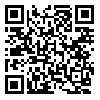Volume 17, Issue 3 (12-2024)
ijhe 2024, 17(3): 547-562 |
Back to browse issues page
Download citation:
BibTeX | RIS | EndNote | Medlars | ProCite | Reference Manager | RefWorks
Send citation to:



BibTeX | RIS | EndNote | Medlars | ProCite | Reference Manager | RefWorks
Send citation to:
Sheykhan A, Moussavi G, Heidari M. Evaluation of ambient air quality in Arak with emphasis on aggregate and health risk-based indices. ijhe 2024; 17 (3) :547-562
URL: http://ijhe.tums.ac.ir/article-1-6922-en.html
URL: http://ijhe.tums.ac.ir/article-1-6922-en.html
1- Department of Environmental Health Engineering, Faculty of Medical Sciences, Tarbiat Modares University, Tehran, Iran
2- Department of Environmental Health Engineering, Faculty of Medical Sciences, Tarbiat Modares University, Tehran, Iran ,moheidari@modares.ac.ir
2- Department of Environmental Health Engineering, Faculty of Medical Sciences, Tarbiat Modares University, Tehran, Iran ,
Abstract: (71 Views)
Background and Objective: The air quality index (AQI) does not account the interaction of multiple pollutants, meaning the high concentration and health risk of one pollutant may amplify the effects of others. The main aim of this study was to characterize the ambient air quality of Arak by assessing the combined effects and health risks associated with criteria air pollutants.
Materials and Methods: This study evaluated the ambient air quality of Arak for the year 1401 on the Persian Calendar, using the concentrations of criteria air pollutants averaged over appropriate timeframes. Additionally, the AQI, aggregate air quality index (AAQI), and health risk-based air quality index (HAQI) were calculated.
Results: Findings showed that the 1-hour concentrations of NO2, SO2, PM10, and PM2.5 exceeded national standards in 0.05%, 0.2%, 12.1%, and 35.5% of hours, respectively. The AQI, AAQI and HAQI values were above 100 in 54.4%, 77.3%, and 56.2% of hours, respectively. PM2.5 was the major pollutant in over 99% of cases.
Conclusion: The results indicated that AAQI and HAQI, in comparison to AQI, characterized the air quality as more polluted. This stricter assessment by AAQI and HAQI may encourage more precautionary measures by authorities and the public. Thus, it is recommended that the decision-makers in Iran’s air quality monitoring in consider adopting these indices.
Materials and Methods: This study evaluated the ambient air quality of Arak for the year 1401 on the Persian Calendar, using the concentrations of criteria air pollutants averaged over appropriate timeframes. Additionally, the AQI, aggregate air quality index (AAQI), and health risk-based air quality index (HAQI) were calculated.
Results: Findings showed that the 1-hour concentrations of NO2, SO2, PM10, and PM2.5 exceeded national standards in 0.05%, 0.2%, 12.1%, and 35.5% of hours, respectively. The AQI, AAQI and HAQI values were above 100 in 54.4%, 77.3%, and 56.2% of hours, respectively. PM2.5 was the major pollutant in over 99% of cases.
Conclusion: The results indicated that AAQI and HAQI, in comparison to AQI, characterized the air quality as more polluted. This stricter assessment by AAQI and HAQI may encourage more precautionary measures by authorities and the public. Thus, it is recommended that the decision-makers in Iran’s air quality monitoring in consider adopting these indices.
Keywords: Ambient air pollution, Air quality index, Aggregate air quality index, Health risk-based air quality index, Arak
Type of Study: Research |
Subject:
Air
Received: 2024/05/9 | Accepted: 2024/08/6 | Published: 2024/12/11
Received: 2024/05/9 | Accepted: 2024/08/6 | Published: 2024/12/11
Send email to the article author
| Rights and Permissions | |
 |
This work is licensed under a Creative Commons Attribution-NonCommercial 4.0 International License. |





